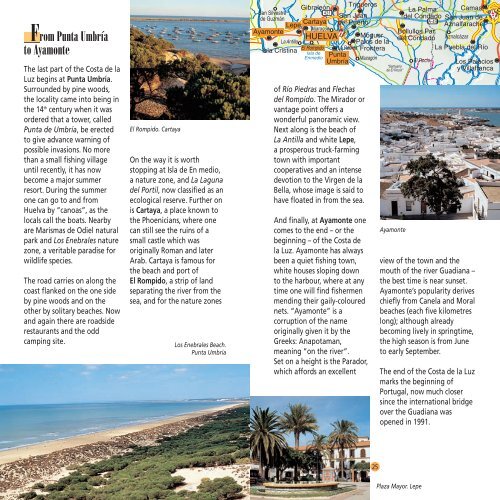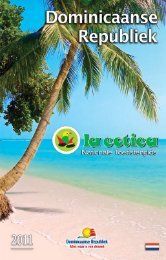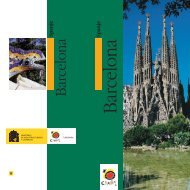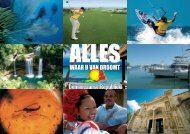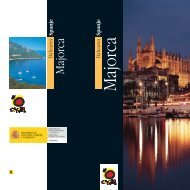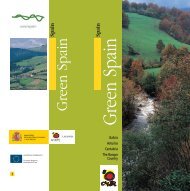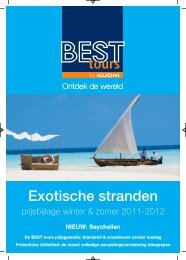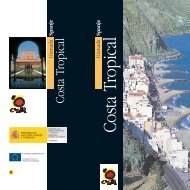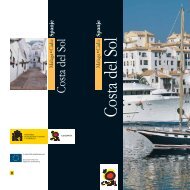Create successful ePaper yourself
Turn your PDF publications into a flip-book with our unique Google optimized e-Paper software.
From Punta Umbría<br />
to Ayamonte<br />
The <strong>la</strong>st part of the <strong>Costa</strong> <strong>de</strong> <strong>la</strong><br />
<strong>Luz</strong> begins at Punta Umbría.<br />
Surroun<strong>de</strong>d by pine woods,<br />
the locality came into being in<br />
the 14 th century when it was<br />
or<strong>de</strong>red that a tower, called<br />
Punta <strong>de</strong> Umbría, be erected<br />
to give advance warning of<br />
possible invasions. No more<br />
than a small fishing vil<strong>la</strong>ge<br />
until recently, it has now<br />
become a major summer<br />
resort. During the summer<br />
one can go to and from<br />
Huelva by “canoas”, as the<br />
locals call the boats. Nearby<br />
are Marismas <strong>de</strong> Odiel natural<br />
park and Los Enebrales nature<br />
zone, a veritable paradise for<br />
wildlife species.<br />
The road carries on along the<br />
coast f<strong>la</strong>nked on the one si<strong>de</strong><br />
by pine woods and on the<br />
other by solitary beaches. Now<br />
and again there are roadsi<strong>de</strong><br />
restaurants and the odd<br />
camping site.<br />
El Rompido. Cartaya<br />
On the way it is worth<br />
stopping at Is<strong>la</strong> <strong>de</strong> En medio,<br />
a nature zone, and La Laguna<br />
<strong>de</strong>l Portil, now c<strong>la</strong>ssified as an<br />
ecological reserve. Further on<br />
is Cartaya, a p<strong>la</strong>ce known to<br />
the Phoenicians, where one<br />
can still see the ruins of a<br />
small castle which was<br />
originally Roman and <strong>la</strong>ter<br />
Arab. Cartaya is famous for<br />
the beach and port of<br />
El Rompido, a strip of <strong>la</strong>nd<br />
separating the river from the<br />
sea, and for the nature zones<br />
Los Enebrales Beach.<br />
Punta Umbría<br />
Gibraleón<br />
San Silvestre<br />
431<br />
<strong>de</strong> Guzmán<br />
Cartaya<br />
Lepe<br />
Aljaraque<br />
Ayamonte<br />
La Antil<strong>la</strong><br />
Is<strong>la</strong> Cristina<br />
HUELVA<br />
El Rompido<br />
Is<strong>la</strong> <strong>de</strong><br />
Enmedio<br />
San Juan<br />
<strong>de</strong>l Puerto<br />
Moguer<br />
Palos <strong>de</strong> <strong>la</strong><br />
La Rábida Frontera<br />
Mazagón<br />
Punta<br />
Umbría<br />
Trigueros<br />
of Río Piedras and Flechas<br />
<strong>de</strong>l Rompido. The Mirador or<br />
vantage point offers a<br />
won<strong>de</strong>rful panoramic view.<br />
Next along is the beach of<br />
La Antil<strong>la</strong> and white Lepe,<br />
a prosperous truck-farming<br />
town with important<br />
cooperatives and an intense<br />
<strong>de</strong>votion to the Virgen <strong>de</strong> <strong>la</strong><br />
Bel<strong>la</strong>, whose image is said to<br />
have floated in from the sea.<br />
And finally, at Ayamonte one<br />
comes to the end – or the<br />
beginning – of the <strong>Costa</strong> <strong>de</strong><br />
<strong>la</strong> <strong>Luz</strong>. Ayamonte has always<br />
been a quiet fishing town,<br />
white houses sloping down<br />
to the harbour, where at any<br />
time one will find fishermen<br />
mending their gaily-coloured<br />
nets. “Ayamonte” is a<br />
corruption of the name<br />
originally given it by the<br />
Greeks: Anapotaman,<br />
meaning “on the river”.<br />
Set on a height is the Parador,<br />
which affords an excellent<br />
La Palma Camas<br />
<strong>de</strong>l Condado San Juan <strong>de</strong><br />
A-49<br />
Aznalfarache<br />
Bollullos Par<br />
<strong>de</strong>l Condado Aznalcázar<br />
La Pueb<strong>la</strong> <strong>de</strong>l Río<br />
“Santuario<br />
<strong>de</strong> El Rocío”<br />
El Rocío<br />
Trebujena<br />
Sanlúcar<br />
<strong>de</strong> Barrameda<br />
Ayamonte<br />
PARQUE NACIONAL<br />
DE DOÑANA<br />
Chipiona<br />
Rota<br />
El Puerto <strong>de</strong><br />
Santa María<br />
CÁDIZ<br />
San Fernando<br />
Chic<strong>la</strong>na<br />
Sancti-Petri<br />
Cabo <strong>de</strong> Trafalgar<br />
view of the town and the<br />
mouth of the river Guadiana –<br />
the best time is near sunset.<br />
Ayamonte’s popu<strong>la</strong>rity <strong>de</strong>rives<br />
chiefly from Cane<strong>la</strong> and Moral<br />
beaches (each five kilometres<br />
long); although already<br />
becoming lively in springtime,<br />
the high season is from June<br />
to early September.<br />
The end of the <strong>Costa</strong> <strong>de</strong> <strong>la</strong> <strong>Luz</strong><br />
marks the beginning of<br />
Portugal, now much closer<br />
since the international bridge<br />
over the Guadiana was<br />
opened in 1991.<br />
Los Pa<strong>la</strong>cios<br />
y Vil<strong>la</strong>franca<br />
Lebrija<br />
IV<br />
Conil <strong>de</strong><br />
<strong>la</strong> Frontera<br />
PARQUE NATURAL BREÑA<br />
Y MARISMAS DE BARBATE<br />
El Cuervo<br />
A-4<br />
Arco<br />
<strong>la</strong> Fro<br />
Jerez<br />
<strong>de</strong> <strong>la</strong> Frontera<br />
Puerto Real<br />
PARQUE NATURAL<br />
DE LA BAHÍA DE CÁDIZ<br />
S<br />
Medina<br />
Sidonia<br />
Benal<br />
Ve<br />
<strong>de</strong> <strong>la</strong> F<br />
Barb<br />
Zahara d<br />
los Atun<br />
Ensenada <strong>de</strong> Bo<br />
Punta Camar<br />
24<br />
25<br />
P<strong>la</strong>za Mayor. Lepe


